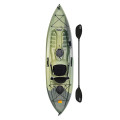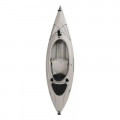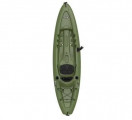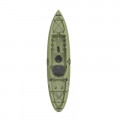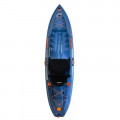Lifetime’s fishing kayaks are easy to find on waterways and in outdoor retail stores across North America. As a major paddlesports brand, Lifetime produces a diverse range of paddlecraft, including sit-inside kayaks, sit-on-top kayaks and standup paddleboards. Their kayaks are intended for both the casual user out for a recreational day, and for the kayak angler chasing fish.
As a company, Lifetime did not get its start in the kayak business, and you probably recognize the name from other consumer products around your yard, including sheds, picnic tables and basketball hoops. In fact, basketball hoops are how Lifetime got its start when founder Barry Mower decided to improve upon his family’s basketball hoop. In 1986 Lifetime officially launched as the first manufacturer of adjustable basketball hoops, and the company grew from there.
In 2010, Lifetime entered the paddling world when the company acquired Dragonfly Kayaks, and further established themselves with the purchase of Emotion Kayaks in 2011.
Lifetime is now one of the largest kayak manufacturers in North America, and produces their kayaks by blow molding high-density polyethylene. High-density polyethylene is the type of plastic you regularly find in items around the house, including milk jugs and shampoo bottles. The blow molding process places a mold around heated plastic and uses forced air to push the plastic to the shape of the mold.
Lifetime’s target audience for fishing kayaks is largely the beginner-to-intermediate level of kayak angler. Lifetime accomplishes this by producing a kayak at lower cost and offering their kayaks at a lower price than higher-end competition. They also predominantly sell their kayaks at large retail chains found across North America, including Dick’s Sporting Goods and Tractor Supply.
The kayak designs and construction of Lifetime kayaks are largely intended for calmer bodies of water. If you are new to paddling and kayak fishing, with plans to paddle shorter distances or your destinations for fishing are sheltered lakes, bays, ponds, slow moving rivers and tidal waterways, then Lifetime fishing kayaks may be right for you.
Top picks: Best Lifetime fishing kayaks for 2024
The following Lifetime fishing kayaks have received the highest star ratings by reviewers in our Paddling Buyer’s Guide. See and review all Lifetime fishing kayaks here.
Best Lifetime Fishing Kayaks
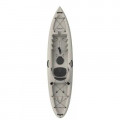
Stealth Angler 110
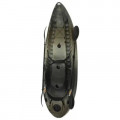
Sport Fisher
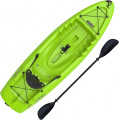
Hydros 85 Angler
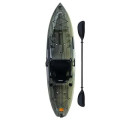
Kenai Pro Angler 100
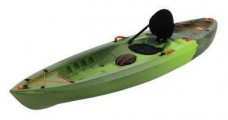
Kenai 103 Angler
Shop Lifetime sit-on-top kayaks
When deciding on the best Lifetime fishing kayak for you, it’s worth taking the time to research the different components of each model. Buying a kayak is not as simple as choosing the cheapest or most expensive kayaks that Lifetime offers. Purchasing your fishing kayak is about understanding which kayak has the best elements for your kayak angling outings.
For starters, Lifetime produces two kayak deck types. There are sit-on-top kayaks and sit-inside kayaks.
Sit-on-top kayaks are kayaks in which the paddler is not enclosed inside the kayak at all. The deck has been molded to provide a seat on the exterior of the kayak hull. The kayak is hollow inside, providing a pocket of air which makes the kayak buoyant, though the interior can usually be accessed through various types of hatches.
A sit-inside kayak is one in which the paddler climbs into the interior of the kayak through what is called the cockpit. Their seat is located inside the hull of the kayak. Think of the open cockpit a pilot climbs into for a single propeller plane, this visualization provides a good picture of the cockpit of a sit-inside kayak, though a kayak is much smaller than a plane fuselage.
The majority of Lifetime fishing kayaks are sit-on-top kayaks, like the popular Tamarack Angler 100. Lifetime also produces sit-inside fishing kayaks such as the Payette Angler 98.
Beyond deck styles, different models of Lifetime kayaks have different specifications including the weight and capacity of the kayak. There are also variations in outfitting, storage and the types of accessories included with each Lifetime fishing kayak.
The above are important factors to consider when deciding on the right Lifetime kayak. You can find the complete specifications, costs and availability of every Lifetime fishing kayak, along with reviews, in our Paddling Buyer’s Guide.
Shopping for a used Lifetime fishing kayak?
If you are in the market for a used Lifetime fishing kayak, there are a few tips on what to look for when purchasing second-hand instead of new.
First, keep in mind the price differential between what the seller is asking and what the Lifetime fishing kayak retails for new. Lifetime fishing kayaks are some of the less expensive fishing kayaks available. Unless the seller is providing a sweetened deal such as a package setup of kayak and accessories, you may be better off buying a Lifetime fishing kayak new. This way you would have a brand new kayak still at a low price, with a warranty accompanying the boat.
Always inspect the kayak in person before agreeing to a purchase. A well-loved, pre-owned Lifetime fishing kayak will have seen a lot of nautical miles, and potentially its fair share of being strapped to a car roof, dragged over rocky beaches, and maybe being stored outdoors for lengths of time. Never agree to buy a used kayak without seeing it in person.
Inspect the kayak for damage. Don’t sweat surface scratches on the hull, they are bound to happen. Instead, look carefully for deep gouges and dents or cracks in the hull of the kayak. Keep an eye out for any repairs previous owners may have made as well. Cracks would be the greatest concern, as these would compromise the kayak as well as allow water to leak into the hull.
When inspecting a sit-on-top kayak for cracks, don’t forget to look within the scupper (drain) holes in the floor. This area of the kayak sees compression and stress, and is hidden from plain sight. Also look around the vicinity of any screws and mounts for signs of stress or cracking.
Be sure the seat of the Lifetime fishing kayak is working properly. Lifetime has different types of seats depending on the model. The Tamarack Angler 100 has a pad on the floor of the kayak seat, with a hinged folding backrest, while the Teton has a raised removable seat with a metal frame. Inspect the seats for any damage, both on the seats themselves as well as where they join the boat as these are potential problem areas.
Kayak modifications can be pretty cool, but be wary of buying a kayak with after-factory mods (unless, perhaps, if it’s the trolling motor mount setup you’ve been drooling over on YouTube). If done incorrectly these modifications can create leaks or be weak points for future damage. Again you may be better off buying new, and being aware of how the modifications have been done yourself.
If possible, take the Lifetime fishing kayak out for a test run on the water before purchasing. This is going to be the best way to know if the kayak is the right fit for you. It will also give you a chance to put the kayak to the test, and be sure the wheels don’t fall off, so to speak.
When you finish test paddling the Lifetime fishing kayak, open the drain plug and see how much water empties out. It’s normal for a very small amount of water to enter the interior of the kayak through screw holes and seams. However, if after 15 minutes of paddling a stream of water comes shooting out, this may be a red flag the boat has a crack or bad leak you were not able to spot.
For more tips on what to look for when selecting a used fishing kayak, read our article How To Buy A Used Fishing Kayak.
Lifetime fishing kayak buying advice
When buying the best Lifetime fishing kayak for your paddling outings, there are a number of factors to consider.
In the section above on shopping for a Lifetime kayak, we discussed the difference between the sit-inside and the more common sit-on-top kayaks produced by Lifetime.
Sit-on-top kayaks are a popular choice for anglers. They provide large open storage areas for tackle, and are easy to enter and exit. Another advantage to sit-on-top kayaks for anglers is that if stability allows they may be used as a standing platform to increase casting and visibility. Also, when a sit-on-top kayak capsizes all you have to do is flip the kayak upright and climb back on.
When looking at the other type of kayak, the sit-inside, you will immediately see the kayak is hollow inside the cockpit. Should you capsize while fishing the kayak would have to be emptied before you can get back in the kayak.
Sit-inside kayaks do have their advantages though. The largest being that your lower half is not exposed to the elements or being splashed by water. You can spend the day staying relatively dry inside a sit-inside kayak.
Beyond the deck type, there are also various hull designs with different characteristics. Different kayak hulls are intended for different types of use.
For example, hulls with rounded edges where the bottom of the kayak transitions gradually up from the bottom into the side may be more maneuverable and capable of paddling through waves. An example of this would be the Lifetime Tamarack Angler 100.
Another hull, the tunnel hull, has a catamaran-like underside, and provides the most stability on calm water. This type of hull is used on kayaks intended to serve as a standing platform, such as the Lifetime Stealth Pro Angler 118.
Lifetime fishing kayaks usually include certain outfitting components to make them ready for kayak fishing, most commonly two rod holders on the deck behind the seat of the kayak. If your main goal is fishing, be sure the Lifetime kayak you are browsing includes these elements at least.
Finally, you will want to consider the storage capacity and options of your Lifetime fishing kayaks, since most Lifetime fishing kayaks include multiple storage areas.
Tankwells on a sit-on-top kayak are a common storage type popular with kayak anglers. Tankwells are recessed areas on the deck to store gear bags and tackle. Often kayak anglers pack their tackle and extra rods in a milk crate, so enough space for a milk crate may be something you check out on the deck of a sit-on-top kayak.
Another type of storage are hatches. Hatches are openings in the kayak that allow you to access the interior. They are commonly found on both sit-on-top and sit-inside kayaks. They are usually covered with either a threaded deck plate or a rubber or plastic hatch cover. Hatches can vary in size, and the covers can vary in water resistance.
Considering how much storage you would like and the storage type you prefer will be one of the most important factors when purchasing your Lifetime fishing kayak.
The best way to know whether you will enjoy a kayak is to take it for a test paddle. This may not be available at retailers carrying Lifetime fishing kayaks, but if you know someone with a model you have an interest in, see if you can take it for a spin.
Compare Lifetime fishing kayaks
-
Lifetime vs Pelican fishing kayak
One of the brands that consistently competes with Lifetime in the fishing kayak market is Pelican kayaks. Pelican is a Canadian company that distributes kayaks throughout North America. You will regularly find Pelican kayaks sharing the water, and the storefront, with Lifetime kayaks.
Lifetime and Pelican fishing kayaks often come in at around the same price and are intended for similar ability levels and waterways. Both kayak brands are also regularly available at large retailers.
Lifetime fishing kayaks and Pelican fishing kayaks also have similar features. Depending on which model you are looking at, Pelican and Lifetime can seem almost identical. A couple of small distinctions concern storage and the seat.
For storage, many of Pelican’s sit-on-top models feature a hatch in the bow of the boat. This hatch provides a large interior storage space within the hull of the kayak. For Lifetime, some models feature a bow hatch, but a number of the Lifetime kayaks do not feature this type of dedicated storage. If hatched storage space is important to you, you may find more options with Pelican.
The other major difference comes down to the construction of these kayaks.
Lifetime uses blow molding to produce their boats. Which is when a tube of plastic in a gelatinous liquified state is placed into a mold, and forced air pushes the plastic outward to take on the shape of the mold.
Pelican kayaks are built using thermoforming, which is when a sheet of plastic at a pliable temperature is placed over a mold and pressed to shape. Pelican kayaks begin as an upper and lower half which are then sealed together. This means the Pelican kayak technically has a seam at this joint around the kayak.
Deciding on a Lifetime or Pelican fishing kayak may come down to which is available at your retailer, or potentially the ability to test paddle one and see which works best for you.
Lifetime fishing kayak reviews
For a dive deeper into a specific Lifetime fishing kayaks, here are our detailed reviews of different models.



